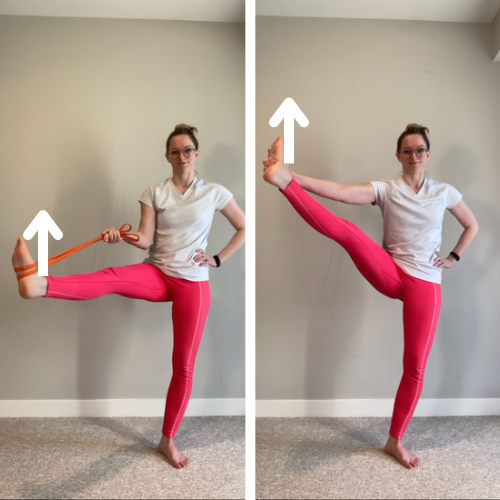How to Do a Y Scale Leg Hold
How to Do a Y Scale Leg Hold
A standing side leg hold, often called a “Y Scale” in the contortion world, is a fun (and impressive!) standing balance that showcases leg flexibility. Unlike a “regular” standing split, a Y Scale is an open split position that allows for both turn-out in the hips, and a tilt of the hips to maximize how high we can lift our leg.
Let’s look at two ways to do this pose: both the traditional standing variation, as well as an easier-to-balance variation lying on the floor.
How To: Standing Leg Hold (Y Scale)
Set Up:
Start standing near a wall. If this is your first time practicing this skill, I suggest literally leaning your hips and back into the wall for balance. As you get more comfortable with the leg lift, then you can work on just having a hand on the wall for balance, and eventually trying to balance without support altogether.
Step 1
Turn out both legs.
Step 2
Bend your right knee out towards the side, grabbing the outside of your right foot with your hand (or looping a strap around the foot and grabbing the strap). Lift the right knee as high as you can, keeping the knee bent.
Step 3
Kick the right leg straight, reaching your toes up towards the ceiling.
Step 4
Finally, add the hip tilt: hike your right hip up as high as you can. So instead of keeping your hips parallel to the floor, we’re trying to tilt our hips at a diagonal (or eventually even trying to stack them on top of each other).
Tada! That’s your Y Scale! Practice getting the leg and hip lifted up leaning into the wall, using your arms to help pull your leg as high as you can (without pain, of course). If that’s feeling coordinated, try that same leg lift and hip tilt without leaning into the wall, just keeping one hand on the wall for balance - then you can try to float your hand away from the wall to try and balance for a moment.
How To: Side-Lying Leg Hold (Side-Lying Y Scale)
Set Up
Start lying on the floor on your left side, with your right hip stacked on top of the left (aka both hip bones pointing forwards). You can keep the left (bottom) leg straight, or choose to bend the knee (which helps with balance), but be sure to keep the thigh in line with the torso (thigh parallel to the outside of your mat), don’t let the knee come forwards if you bend it.
Step 1
Bend your right (top) leg and either grab the foot with your hand, or loop a strap around your foot and grab the strap.
Step 2
Kick the right leg straight, using your arm to pull the leg towards your side body. And that’s your side-lying Y Scale! It’s virtually the same position as standing, but a bit easier to really focus on the flexibility component when you aren’t a) fighting gravity and b) trying to balance on one foot.
Note for very bendy students: If you have a lot of hamstring flexibility and can get your thigh all the way to touch the side of your ribs, or your knee to touch your shoulder, aim to pull the right leg behind your right arm/shoulder (behind your torso, not in front).
How to Lift the Leg Higher / Make it More Split-y
Doing exercises that strengthen your muscles while you’re in this stretched position, like contract-relax, aka PNF, is a great way to increase your flexibility for this pose. For more ideas on active flexibility drills you can work on to make this shape look split-ier, check out some of my favorites in this blog post, or try the Y Scales (Leg Holds) workshop for a full 60+ min stretching routine focused on this skill!









